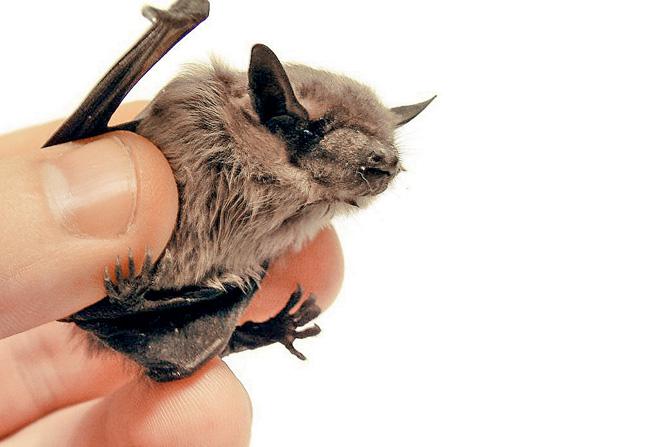This weekend, as 30 countries observe International Bat Night, here's what you need to know about the flying mammal and where you can spot its colonies in Mumbai

A colony of Indian flying foxes, a frugivorous species; (below, left) the insect-eating species are delicate and weigh no more than 25 grams
They are nocturnal. They hang upside down. They fly but aren’t birds. They reside in tall trees and crevices of abandoned buildings. And that’s just about enough for humans to create an enigma around bats, which ranges from innocuous intrigue and fear to countless myths and superstitious beliefs, making them permanent fixtures in horror movies. But there is more to the winged creature, and the only sense of intrigue that can arise after learning more about it would allude to the wondrous ways of nature.
Since 1997, over 30 countries have been observing International Bat Night on the last full weekend of August, under which nature conservation agencies and NGOs from across Europe pass on information to the public about the habitat of bats and their ways through exhibitions and bat walks. While India is not a participating country, it is home to 119 different species of bats. And though pigeons and crows make up a good chunk of Mumbai’s avian population, colonies of bats can be found across the city, too. So cast off all fear to meet the only flying mammal in nature.
ADVERTISEMENT
Fact check

It was during her masters dissertation on the spotted deer in the Andaman Islands that Bandana Aul Arora first got the opportunity to engage with bats. They hit it off instantly, and for the next decade, the then BNHS researcher and now bat conservationist kept returning to the archipelago to study them. Much in contrast to their dreaded image, Arora tells us that bats are quite delicate. "You have to be really careful while handling them so as not to crush their bones. Before I went on to handle a bat for the first time, I trained at the Madurai Kamaraj University to ensure I don’t injure them," she says.
Most bat species found in India can be divided among fruit-eating and insect-eating varieties. Those weighing more than 25 grams usually belong to the former, while the latter are tiny creatures, which fall under the suborder Microchiroptera. "The commonly spotted Indian flying fox is a fruit-eating bat. They are bulkier and don’t fly at great speed. It’s the insectivorous species that need acrobatic movements," she explains.
Bats are social animals, living in colonies atop tall and sturdy trees, or in caves and abandoned buildings. "The mother and child roost at the centre, surrounded by adults, while the senior-most adults perch themselves along the peripheries," says Arora.
Blinded by myths
 Dr Ashok Manekar
Dr Ashok Manekar
From blood-thirsty creatures to bats getting stuck in the hair, the myths that surround these flying mammals are countless. Dr Ashok Manekar, who retired from the University of Mumbai’s Institute of Science and is a member of the International Society of Bat Conservation, tells us, "There are no species of vampire bats found in India. We only have the false vampire bat."
 Bandana Aul Arora
Bandana Aul Arora
And bats are certainly not blind. In fact, the fruit-eating varieties have excellent vision to spot their favourite mangoes and guavas, informs Arora. The circling motion they seem caught in if they mistakenly enter your home is simply because they are trying to find their way out and are just as scared of you, as you are of them! About the myth that bats love human hair and can cause baldness, all Arora has to say is that baldness at an early age has got to do with genetics.
We need bats
With all the misconceptions surrounding the bat story, it isn’t just paranoia that defines the human relationship with bats. It’s not uncommon to see indiscriminate felling of trees that are home to colonies of bats. “In fact, people often resort to fumigating their colonies, when all that needs to be done to persuade bats to move away is covering their access areas,” explains Arora.
Much like any creature, bats have a crucial role to play in nature. "The frugivorous species play an important part in dispersal of seeds," says Dr Manekar. "They are also pest repellents," adds Arora, adding how bats have been anything but a bad omen, earning her the repute of being among the few bat conservationists in India. "They have a great perspective on life, roosting upside down. For, that’s how most things in life are."
Bat zones of Bombay

While the colonies in Mumbai University’s Kalina campus, and Kanheri Caves can no longer be seen, they are found in Dadar Parsi Colony, Veermata Jijabai Udyan, Byculla (in pic), Elephanta Caves, Vangani railway station (en route to Nashik) and inside the railway tunnels towards Pune. A ficus tree opposite the Maharashtra State Police Headquarters in Colaba is home to several bats, too.
Catch up on all the latest Mumbai news, crime news, current affairs, and also a complete guide on Mumbai from food to things to do and events across the city here. Also download the new mid-day Android and iOS apps to get latest updates
 Subscribe today by clicking the link and stay updated with the latest news!" Click here!
Subscribe today by clicking the link and stay updated with the latest news!" Click here!







